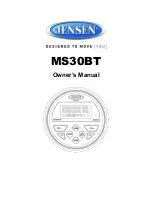
1.1
Understanding The DXPT1 Board
Through time division multiplexing, the DXPT1 board greatly increases the efficiency and economy of the DXP
Plus system by providing up to 24 channels on two twisted metallic pairs. This multiplexing technique allows
two-way voice or data communications at 1.544 Mbps (million bits per second) with either a central office (CO),
public branch exchange (PBX), or another digital communications system (DXP Plus). The DXPT1 board
includes a built-in customer service unit (CSU) but there is no restriction on adding an external CSU.
When you connect two DXP Plus systems together using E&M protocol through the T1 lines, designate one DXP
Plus as the master and the other one as the slave. In this application, only the slave DXP Plus system requires a
DXOPT–SYN card.
When the T1 option is installed, the DXP Plus supports the following signaling protocols per channel.
•
Loop Start (subscriber end only)
•
Ground Start (subscriber end only)
•
E&M two- or four-wire tie lines
•
DID (direct inward dial)
Loop Start and Ground Start will support synchronized ring, hook flash, and pause. Dialing can be DTMF (tone)
or dial pulse. For E&M and DID tone operation, check the number of DTMF receiver cards needed in the system
E&M and DID will support wink start, delay dial, and immediate dial (dial pulse only). Dialing can be tone or dial
pulse.
1.2
Understanding The DXOPT-SYN Synchronization Card
The DXOPT–SYN card uses a reference timing frequency of 8 KHz that it derives from the 1.544 MHz frequency
supplied to the DXPT1 board by the central office (CO) or other external source. By referencing this 8 KHz with
8 KHz timing derived internally, the master 16.384 MHz voltage-controlled oscillator (VCO) can be
synchronized. The T1 transmit clock (1.544 MHz) is derived from the 16.384 MHz frequency on the DXPT1
board. If the 1.544 MHz received frequency is incorrect (not within a 200 Hz tolerance), the system may loose
synchronization with the CO or other external source. The DXOPT–SYN card reports this condition by turning on
the appropriate alarms on the DXPT1 board and DXOPT–SYN card. A loss of clock synchronization causes
frame slips that result in data communications errors.
The DXOPT–SYN card allows two timing references ( primary and secondary) to be selected. You can select
either automatic or manual (for maintenance mode). In the automatic mode, a loss of primary timing causes the
system to switch to the secondary timing reference. If both the primary and secondary timing references are lost,
the VCO oscillator on the DXOPT–SYN card is defaulted to the fixed 16.384 MHz oscillator on the services
board. This results in the loss of T1 clock synchronization.
IMI89–193
Installing The DXPT1 Line Board
2 – Installing The DXPT1 Line Board
















































